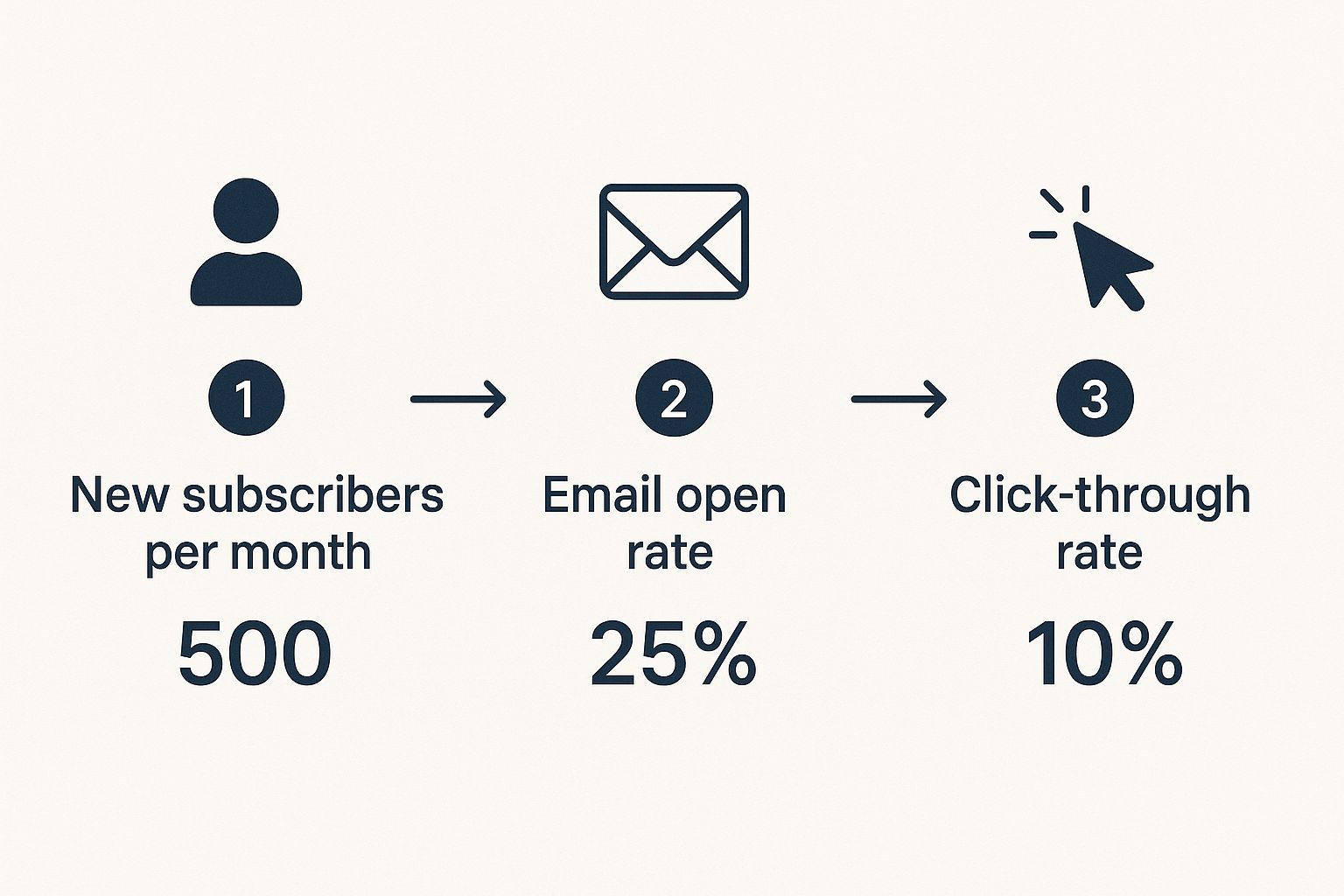For any construction business, relying solely on word-of-mouth referrals is a high-risk game. While a good referral is gold, they’re unpredictable and put the future of your business entirely in someone else’s hands.
To build a resilient, scalable company, you need to move past that reactive mindset where you just wait for the phone to ring. It’s time to build a proactive, well-oiled machine for construction lead generation.
Moving Beyond Referrals for Sustainable Growth

A consistent flow of qualified leads is the lifeblood of any successful construction business. It’s what gives you the stability to invest in your team, upgrade equipment, and confidently bid on the bigger, more profitable projects you’ve been eyeing. It’s about taking control of your pipeline and ensuring sustainable growth, not just hoping for it.
Understanding the Current Australian Construction Climate
The Australian construction sector right now is a mixed bag of opportunity and challenge. There’s a clear divide between booming publicly funded infrastructure and privately funded developments that are feeling the strain.
As of 2025, government-backed projects are looking strong, with over 8,000 active projects valued at more than $500 billion. On the flip side, private developers are battling serious headwinds from rising costs, labour shortages, and tighter lending. For these businesses, effective lead generation isn’t just for growth—it’s essential for survival.
This competitive environment means you simply can’t afford to be passive. You have to actively hunt down and secure the right kind of work.
Defining Your Ideal Construction Client
The first real step in building your lead generation engine is knowing exactly who you’re trying to attract. A vague target like “anyone who needs a builder” will just lead to wasted time, money, and effort. You need to get specific and create a detailed Ideal Client Profile (ICP).
Your ICP should go way beyond just basic project types. Think about these attributes:
- Project Budget: What’s the minimum and ideal project value you’re targeting? This immediately helps you focus on leads that are actually profitable for your business.
- Geographic Location: Define your service area precisely. Are you focused on a specific suburb, the entire Gold Coast, or a wider region?
- Project Scope: What’s your sweet spot? Do you specialise in high-end residential renovations, commercial fit-outs, or new custom home builds? Be specific.
- Client Personality: Do you work best with hands-on clients who are deeply involved, or do you prefer those who delegate and trust your expertise?
Getting this clarity is crucial. It informs every single marketing decision you make, from the photos you post on Instagram to the keywords you target on your website.
Your ideal lead generation strategy should focus on three core pillars: a powerful Digital Presence to attract prospects, active Digital Marketing to engage them, and strategic Lead Nurturing to convert them into clients. Mastering these areas creates a repeatable system for growth.
Setting Clear and Measurable Goals
With a crystal-clear picture of your ideal client, the next move is to set tangible goals for your lead generation efforts. These goals are your blueprint, giving you a clear way to measure success and adjust your strategy on the fly.
For your goals to be effective, they need to be SMART: Specific, Measurable, Achievable, Relevant, and Time-bound.
- Instead of: “Get more leads.”
- Try: “Generate 10 qualified leads for commercial fit-outs in the Gold Coast region per month through our website within the next six months.”
This specific goal gives you a clear target to work towards. You can track your progress, see what’s working, and ditch what isn’t. It’s also worth noting that just as construction businesses look for ways to generate leads, many successful contractors are also finding big wins in streamlining contractor operations with Zapier and AI to boost efficiency and customer satisfaction, which ultimately fuels sustainable growth.
Building a Digital Storefront That Converts
Your website is much more than an online brochure; it’s your hardest-working sales office, open 24/7 to capture and convert leads. If you want your construction lead generation to pay off, your website needs a single, clear purpose: turning casual visitors into genuinely interested prospects.
Think about it this way: if a potential client lands on your site and can’t immediately see the quality of your work or figure out how to contact you, they’re gone in seconds. Your digital storefront has to look professional, feel trustworthy, and be dead simple to navigate.
Creating a Powerful Project Showcase
A generic list of services just won’t cut it anymore. Today’s clients demand proof of your expertise. This is where a high-impact project gallery and detailed case studies become your most powerful sales tools.
Your project gallery should be a visual testament to your best work.
- Invest in High-Quality Photography: Grainy, poorly-lit phone photos scream amateur. Hire a professional photographer to capture your finished projects. Great visuals communicate quality and professionalism before a visitor reads a single word.
- Organise Projects Logically: Group your projects by type, like “Residential Renovations,” “Commercial Fit-outs,” or “Custom Home Builds.” This helps prospects quickly find examples that are relevant to their own needs.
- Show Before-and-After Shots: For renovations or remodelling, nothing tells a story better than a dramatic before-and-after comparison. It’s an immediate and powerful way to showcase your ability to transform a space.
Going beyond a simple gallery, detailed case studies give the story behind the visuals. Each one should walk a prospect through a project from start to finish, outlining the client’s problem, your innovative solution, and the outstanding final result.
A well-crafted case study does more than show off a finished project; it demonstrates your problem-solving ability, your process, and your commitment to client satisfaction. This is how you build trust before you’ve even had a conversation.
The Power of Social Proof and Clear Calls to Action
What other people say about you is far more convincing than what you say about yourself. That’s why weaving powerful client testimonials into your website is non-negotiable. Sprinkle these throughout your site, especially on your homepage, service pages, and inside your project case studies.
A strong testimonial is specific. Forget “Great job!”. You want quotes that highlight specific strengths, like, “They finished the project on time and under budget, and their communication was excellent throughout the process.”
Once you’ve built that trust, you need to tell visitors what to do next. This is the job of your Call to Action (CTA). Your CTAs should be clear, concise, and placed where they’ll make an impact. Use action-oriented language like “Request a Free Consultation” or “Get Your Project Estimate.” Drop these buttons and links right after a compelling case study or at the end of a service description.
Demystifying SEO for Construction Companies
Having a brilliant website is pointless if nobody can find it. This is where Search Engine Optimisation (SEO) comes into play. SEO is all about fine-tuning your website to rank higher in search engines like Google when potential clients are looking for the exact services you offer.
A huge part of this is local SEO, which zeroes in on making you visible to clients in your specific service area. Your number one tool here is a fully optimised Google Business Profile. Make sure it’s filled out completely with your correct business name, address, phone number, hours, and a link to your website. Don’t be shy about encouraging happy clients to leave reviews, as this heavily influences your local ranking.
Targeting the right keywords is also essential. Put yourself in your ideal client’s shoes—what would they type into Google? Instead of a broad term like “builder,” focus on more specific, location-based phrases like “custom home builder Gold Coast” or “commercial renovation experts in Broadbeach.” By using these terms naturally across your website, you’re telling Google exactly what you do and where you do it, boosting your chances of showing up in those valuable local searches. For a deeper dive, our guide on SEO for tradies offers more specific strategies you can implement right away.
Executing Digital Marketing That Attracts Clients

Once you’ve got a high-converting website, it’s time to stop waiting for leads to find you and start actively chasing them down. Your website is the foundation, but a proactive digital marketing plan is the engine that drives consistent construction lead generation. It’s all about showing up where your ideal clients are and putting the right message in front of them at the right time.
A smart digital marketing strategy isn’t about doing everything at once. It’s about a measured mix of paid ads, social media engagement, and valuable content. Each of these channels has a unique role to play in attracting different types of leads at various points in their journey.
Winning with Strategic Social Media
Using social media for a construction business isn’t just about posting a few photos of a finished job. It’s about building genuine connections with specific audiences on the platforms they actually use. A one-size-fits-all approach is a recipe for wasted time and money.
If you’re chasing commercial projects, LinkedIn is non-negotiable. It’s the digital handshake that connects you with architects, developers, and project managers. You can share detailed case studies on complex commercial builds or write about industry trends to position yourself as an authority. In Australia, LinkedIn is a B2B powerhouse, with 80% of B2B leads from social media coming from this platform alone.
For residential builders, the game is different. Visual platforms like Instagram and Pinterest are where you’ll strike gold. These are perfect for showcasing breathtaking home renovations, custom builds, and high-end finishes that speak directly to homeowners. Use top-notch photos and video reels to create a portfolio that doesn’t just show what you do—it inspires people to dream about what you could build for them.
Running Targeted Pay-Per-Click Ad Campaigns
While good SEO builds your organic traffic over the long haul, Pay-Per-Click (PPC) advertising—especially Google Ads—gives you instant visibility. It’s how you get your business in front of prospects with high commercial intent, meaning they’re actively searching for a solution right now.
Think about the phrases a motivated client would type into Google. They’re not just browsing; they’re searching for “commercial builder gold coast” or “kitchen renovation quote sydney”. By bidding on these keywords, your ad pops up at the very top of their search results, grabbing their attention at the exact moment they need you.
To get the most out of your PPC budget, you need to be strategic:
- Location Targeting: Don’t waste money showing ads to people outside your service area. Target specific suburbs or cities.
- Negative Keywords: Build a list of terms you don’t want to show up for (like “jobs,” “training,” or “cheap”) to filter out irrelevant clicks.
- Compelling Ad Copy: Write ads that speak directly to a client’s problem and offer a clear solution. Something like “Award-Winning Home Renovations. Get a Free Consultation.” works wonders.
The real beauty of PPC is how measurable it is. You can track every dollar spent, see exactly how many leads it generates, and calculate your return on investment. This allows you to constantly refine your campaigns for better and better results.
Creating Content That Captures and Converts
Content marketing is your long game. It’s how you build trust and capture leads well before they’re ready to pick up the phone. The goal is to answer your potential clients’ biggest questions and establish your company as the go-to expert.
Instead of just writing about your services, create helpful blog posts, guides, or videos that solve a problem for them. Think about content that answers questions they’re already asking:
- “How Much Does a Second-Storey Extension Cost in Melbourne?”
- “What to Look for When Hiring a Commercial Builder”
- “A Step-by-Step Guide to the Custom Home Building Process”
This kind of content attracts people in the early research stages. By providing genuine value upfront, you build a relationship and establish credibility. When they’re finally ready to hire, your company will be the first one that comes to mind. This is a core idea in any solid digital marketing for tradies plan that prioritises building an audience over time.
By weaving these digital marketing tactics together, you create a powerful system for generating construction leads. Social media builds your brand, PPC captures ready-to-buy leads, and content nurtures future clients. To truly optimise your outreach, you should always be looking to expand your toolkit with diverse effective lead generation techniques that round out your strategy.
Winning Leads Through Relationships and Referrals

While a smart digital marketing strategy casts a wide net, the construction industry still runs on trust and personal connections. Let’s be honest: the best leads—the ones that turn into profitable, enjoyable projects—almost always come from a warm introduction, not a cold click.
Modernising your offline tactics for construction lead generation is about turning those simple handshakes into a reliable pipeline of high-quality work. This isn’t just about swapping business cards at a trade show. It’s about strategically building a referral ecosystem where other professionals want to send projects your way. In an industry where your reputation is everything, these relationships are pure gold.
Building Your Professional Referral Network
The real secret to a killer referral network? Stop seeing other industry pros as competition and start seeing them as collaborators. Your goal is to become the first builder they think of when a project lands on their desk that’s a perfect fit for you.
Your network should be a diverse mix of professionals who are already talking to your ideal clients—often long before you are.
- Architects and Engineers: They’re at the very beginning of new builds and major renovations. A solid relationship here means you get brought into the conversation during those critical planning stages.
- Real Estate Agents: These folks are constantly working with buyers looking to renovate or developers who need a builder for a new project. They can be an incredible source of both residential and commercial leads.
- Complementary Subbies: Think of the electricians, plumbers, or landscapers you already trust and work with. If they’re on a job that suddenly needs a reliable general contractor, you want to be their first call. You can do the same for them, creating a partnership that benefits everyone.
- “Friendly” Competitors: It might sound strange, but you probably don’t bid on the exact same jobs as every other builder in town. If a competitor gets a lead that’s too small, too large, or outside their specialty, they could pass it on to you—if they trust your work.
The most powerful referral partnerships I’ve ever seen are built on a “give to get” mentality. Be the one who actively looks for chances to send work to your network partners. That goodwill almost always comes back to you, usually in the form of pre-qualified leads that are ready to go.
Networking That Actually Generates Leads
Let’s face it, attending industry trade shows and local business events can sometimes feel like a chore. But if you change your mindset, you can turn them into goldmines. Forget trying to talk to everyone in the room. Your mission is to make just a few genuine connections.
The goal isn’t to launch into a sales pitch on the spot. It’s to start a real conversation. Ask about their business, the projects they enjoy, and the challenges they’re facing. Listen more than you talk.
The real work starts after the event. Send a personalised email or a LinkedIn connection request that actually mentions what you talked about. This simple act immediately sets you apart from the 90% of people who do nothing. That fleeting chat just became the foundation of a real professional relationship.
Elevating Your Brand Through Community Involvement
Never underestimate the power of your local reputation. Getting involved in your community is a powerful, and often overlooked, tool for construction lead generation. It builds visibility, but more importantly, it builds trust. It turns your company name into a brand that locals recognise and respect.
Think about smart community engagement, like sponsoring a local youth sports team or getting your crew involved in a community clean-up day. These actions show you’re invested in the area where you work and live.
When a local business owner or family needs a builder they can truly depend on, the company that supports their community will be the first one that comes to mind. This is how you build the kind of deep trust that turns local visibility into lucrative project leads.
Turning Hot Leads Into Signed Contracts
Generating a new lead is a great first step, but it’s just that—a start. The real skill in successful construction lead generation is turning that initial flicker of interest into a signed contract. This is exactly where a lot of businesses stumble, letting promising opportunities go cold simply because their follow-up is too slow or disorganised.
The process of nurturing a prospect until they become a paying client is where the money is made. It calls for a structured approach to make sure no lead ever falls through the cracks, whether you’re using a fancy CRM system or a trusty spreadsheet.
This funnel shows how an initial pool of interested people gets smaller at each stage of the marketing process.

As you can see, even with a healthy number of initial subscribers, only a fraction will actually engage and move forward. This really drives home the importance of an effective nurturing process to get the most out of every lead you generate.
The Critical First Contact
In this game, speed is everything. In a competitive market, the first builder who makes professional contact often sets the standard and has the best shot at winning the job. When a lead comes in, you should be aiming to reach out within the hour, if not sooner. That kind of promptness immediately shows you’re professional and keen.
That first phone call is crucial. Your goal isn’t to close the deal on the spot but to qualify the lead and start building some rapport.
Here’s a simple framework for that initial call:
- Acknowledge Their Enquiry: Start by referencing how they got in touch. “Hi [Prospect Name], it’s [Your Name] from [Your Company]. I’m just following up on the enquiry you sent through our website about your kitchen renovation.”
- Ask Open-Ended Questions: Get them talking about what they have in mind. Try something like, “Could you tell me a bit more about what you’re envisioning?” or “What are the biggest frustrations with your current space?”
- Listen Actively: This is where you strike gold. Pay close attention to their needs, their timeline, and their budget. This information will be invaluable when you put together your proposal later on.
- Set the Next Step: Always end the call with a clear plan. “Based on what you’ve described, the next best step would be for us to schedule a brief on-site consultation. Are you free sometime next week?”
This approach turns a simple follow-up into a productive conversation, positioning you as a helpful expert right from the get-go.
Your follow-up process shouldn’t feel like a sales pitch. It should be a guided journey where you act as a trusted advisor, helping the client solve their problem and realise their vision with your expertise.
Mastering The Consultation And Proposal
The on-site consultation is your time to shine. It’s where you go from being a name on a screen to a tangible, expert partner they can trust. Use this meeting not just to check out the technical side of the job but also to really get a feel for the client’s emotional drivers. Are they looking for more space for a growing family? Are they trying to create their dream entertaining area?
When you understand the “why” behind the project, you can frame your solution so much more effectively. This is a fundamental concept that applies to all marketing efforts; you can explore more practical ideas in our guide covering digital marketing tips for small business.
Finally, your proposal needs to be more than just a list of costs. A winning proposal is a problem-solving document. It should clearly:
- Restate the Client’s Problem: Show them you were listening by summarising their challenges and goals, ideally using their own words.
- Present Your Solution: Detail how your approach will solve their problem and deliver the outcome they want. Don’t just list materials; explain how those materials contribute to their final vision.
- Frame the Value: Clearly outline the benefits of working with you—your experience, your process, your warranty—and connect it all back to the client’s goals.
- Provide Clear Pricing: Break down the costs logically so the client understands exactly what they’re paying for. No surprises.
By transforming your proposal from a simple quote into a comprehensive solution, you make signing that contract an easy, confident decision for the client.
Answering Your Construction Lead Generation Questions
When you start digging into construction lead generation, it’s natural to have a lot of questions. Getting clear, practical answers is what separates a successful strategy from one that just burns through cash and time. Let’s tackle some of the most common questions we hear from contractors.
Think of this as a quick FAQ to help you refine your approach, avoid common mistakes, and get a better return on every dollar you spend.
How Much Should a Contractor Budget for Lead Generation?
There’s no single magic number here, but a solid rule of thumb is to set aside 5-10% of your target revenue for marketing. What you do with that budget depends on where your business is at.
If you’re just starting out, that money is best spent on the essentials: a professional website that works and a solid local SEO foundation to get your name on the map.
For an established company, you might pour more of that budget into highly targeted Google Ads campaigns or creating valuable content that pulls in ideal clients.
The most critical number to keep your eye on is your Cost Per Acquisition (CPA) for each channel. This tells you exactly how much you’re spending to land a single project, so you can confidently double down on what’s actually making you money.
Is Digital Marketing or Traditional Networking Better?
Honestly, the most successful contractors don’t pick a side—they make both work together. It’s not an either/or situation.
A strong digital presence is incredible for casting a wide net and reaching clients who are actively online searching for your services. It works for you 24/7, it’s measurable, and you can scale your efforts up or down.
But you can’t beat traditional networking and word-of-mouth for building deep, genuine trust. Those leads often come pre-vetted and are far easier to convert. The real magic happens when you use your digital tools to support your offline relationships. Met an architect at an industry event? Connect with them on LinkedIn later that day. It keeps the conversation going and keeps you top-of-mind.
How Long Until SEO Starts Generating Construction Leads?
SEO is a marathon, not a sprint. It’s a long-term play that builds a valuable asset for your business. You can expect to see some encouraging movement in your website traffic and rankings within 3-6 months of consistent, focused effort.
However, getting to the good stuff—like landing on the first page of Google for your most profitable services—usually takes somewhere between 6-12 months. Factors like your website’s history, how fierce the local competition is, and how aggressively you pursue it all play a part. To get a head start, you can learn how to boost your local business with SEO with strategies that really work.
It definitely requires patience, but the long-term payoff from a steady stream of organic leads is almost always worth it.
Ready to build a reliable pipeline of profitable projects? Titan Blue has over 25 years of experience helping Australian businesses grow with proven digital strategies. Let us design a custom plan to generate the quality leads your construction business deserves.




